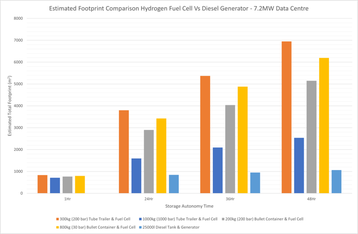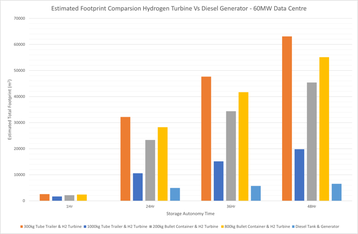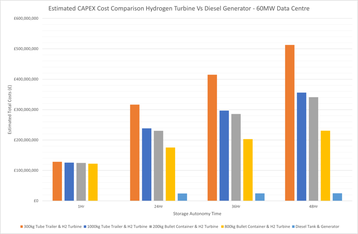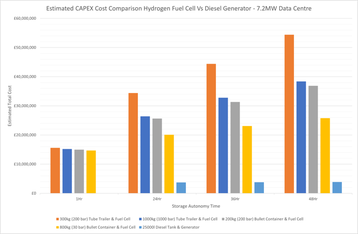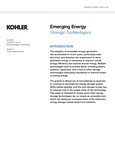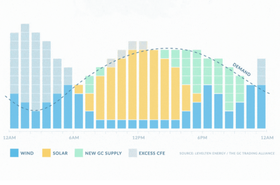Climate change and the race to net zero is one of the biggest engineering challenges society faces over the coming years.
Our reliance on fossil fuels encompasses nearly all industries and the data center sector is no different. Following the COP26, 27 and 28 summits (and building on recent commitments from major data center providers) there has been a renewed focus on achieving data center “net-zero."
However, one of the current barriers to decarbonization is sector reliance on standby diesel generators, which not only produce harmful emissions but also have a negative impact on air quality in the communities surrounding data center sites.
A potential, much vaunted, replacement for diesel is transitioning to hydrogen as a means of storing energy. Hydrogen is being evaluated by different industries for a wide range of applications, and data centers should be no different.
Why Hydrogen?
Hydrogen is one of the most abundant elements in the universe, both industry and governments have heightened their interest in this versatile element as a key part of their decarbonization policies.
The European Commission anticipates industrial investments in renewable hydrogen production to reach €180-470 billion by 2050.
Moreover, the UK government has set its sights on achieving 10 gigawatts of hydrogen production by 2030, underscoring hydrogen's crucial role in the nation's journey towards net-zero emissions.
When considering the opportunities for hydrogen, it is important to consider the difference between energy storage systems and energy generation systems.
Hydrogen’s potential typically falls into the energy storage category, where electricity (preferably from renewable sources) is utilized to generate low-carbon hydrogen which in turn is transported and stored before being converted back into electrical energy.
For data center applications, two potential methods for converting hydrogen back to electrical energy are hydrogen fuel cells and hydrogen-powered gas turbines.
Fuel cells are well-suited for smaller-scale applications, such as replacing diesel generators in single facilities, while turbines excel in generating high megawatt outputs, making them more suited to larger campuses.
Challenges to hydrogen use in data centers
It would be naive to think the adoption of hydrogen in the data center sector doesn’t face short-term challenges.
Standards such as the UK Government's "Low Carbon Hydrogen Standard" are still in their infancy thus making medium-term operating cost predictions challenging.
Further challenges are unearthed when evaluating the capital expenditure and space requirements for switching from traditional diesel generators to hydrogen-based energy storage systems.
An effort to assess the challenges presented by footprint and special requirements has recently been undertaken by EUDCA members, Arup. To cover a broad spectrum of data center deployments, two scenarios (and technologies) were considered: a 7.2MW data center implementing 1MW polymer electrolyte membrane (PEM) hydrogen fuel cells and a 60MW facility implementing 100 percent hydrogen-fueled gas turbines.
The study also considered typical data center power autonomy (24 to 48 hours fuel storage), as well as a one-hour autonomy scenario to highlight the potential of sites provided with access to resilient hydrogen gas utility connections.
Due to challenges associated with the storage of liquid hydrogen and to facilitate a straightforward comparison, hydrogen was assumed to be stored as a gas within either fixed “bullet containers” or mobile “tube trailers."
The storage pressure requirements varied significantly depending on the type and size of the systems being evaluated, which had a notable impact on the spatial footprint necessary for implementation.
For all scenarios evaluated, both the capital expenditure and footprint requirements were significantly increased compared to the incumbent technology.
The space requirement for hydrogen deployment is at least 2.5 times larger than that required for diesel standby generation, while capital expenditure could be five times greater or more.
This increase is predominantly due to the complexity of storing large amounts of hydrogen, which directly equates to increased capital expenditure.
Also of note is the variation between hydrogen storage technologies; for example, 300kg tube trailers are consistently both the most footprint-intensive and costliest solution.
In this scenario, footprint savings are made possible by moving to 1,000kg tube trailers, however, these still maintain a high capital expenditure.
The future?
While there are currently challenges with capital expenditure and footprint requirements, it is important to consider these within the broader context of decarbonization and hydrogen's early stage as a commercial energy storage solution.
With the increasing push towards achieving net zero, it is widely expected that both the capital expenditure and footprint requirements for hydrogen energy storage systems will decrease.
This decrease, together with the significant government investment in the technology which is anticipated, may continue to sway the balance in favor of hydrogen.
Government subsidies have already facilitated the wider adoption of other low and zero-carbon technologies such as heat pumps and photovoltaics, therefore it should be expected a similar pattern may emerge with hydrogen energy storage.
As hydrogen continues to capture attention and investment, its potential for transforming industries and driving a sustainable future remains promising.
Data centers have the opportunity to drive the continued development of the hydrogen economy while advocating for it as a crucial pillar of decarbonization.
This opportunity should be embraced, and whilst short-term challenges exist, they should not detract from the long-term benefits of a hydrogen-based future.
This article published on behalf of the EUDCA Technical Committee


